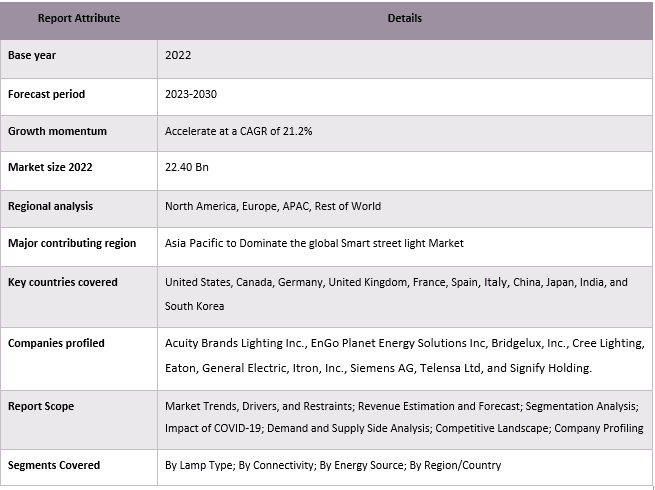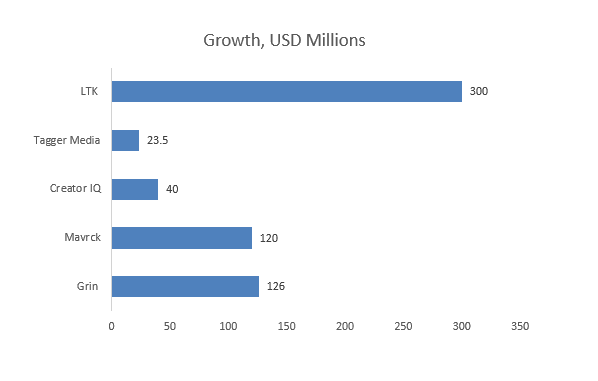- Home
- About Us
- Industry
- Services
- Reading
- Contact Us
Smart Street Lighting Market: Current Analysis and Forecast (2023-2030)
Emphasis on Lamp Type (LED, CFL, Incandescent, and Others); Connectivity (Wired and Wireless); Energy Source (Traditional and other Renewable Energy and Solar); and Region/Country
The Global Smart Street Light Market was valued at USD 22.40 in 2022 and is expected to grow at a CAGR of 21.2% during the forecast period (2023-2030). One of the key drivers for adopting smart street lighting is the potential for energy savings. With the integration of technologies like LED lighting and motion sensors, smart street lighting systems can adjust brightness levels based on real-time conditions, reducing energy consumption significantly. Further, the growing emphasis on sustainable solutions is driving the adoption of smart street lighting. By reducing energy consumption and carbon emissions, these systems contribute to urban sustainability goals and promote greener cities. In addition, various public-private partnerships to install smart street lighting in cities are further propelling its market growth.
Acuity Brands Lighting Inc., EnGo Planet Energy Solutions Inc, Bridgelux, Inc., Cree Lighting, Eaton, General Electric, Itron, Inc., Siemens AG, Telensa Ltd, and Signify Holding are some of the key players in the market. Several M&As along with partnerships have been undertaken by these players to facilitate customers with hi-tech and innovative products/technologies.
Insights Presented in the Report
“Amongst lamp type, LED segment to witness higher CAGR during the forecast period.”
Based on the lamp type, the smart street lighting market is classified into LED, CFL, Incandescent, and others. The LED segment caters to significant demand in 2022. Factors such as LED offers a longer lifetime, lower energy consumption, and reduced maintenance cost when compared with conventional street lighting systems. Furthermore, LED technology provides better light quality with its high color rendering index, which enhances visibility and improves the overall perception of surroundings at night. This can contribute to increased safety for pedestrians and drivers.
“Amongst energy sources, the traditional and renewable energy segment to hold a significant share in the market in 2022.”
Based on energy sources, the smart street lighting market is categorized into traditional and other renewable energy and solar. The traditional and renewable energy segment caters to significant demand in the market. Smart street lighting involves the integration of advanced technologies with street lighting systems to enhance energy efficiency and overall functionality. When it comes to the energy sources for smart street lighting, a combination of traditional and renewable energy can be utilized. Therefore, by combining traditional energy sources with renewable options, smart street lighting can maximize efficiency and minimize carbon emissions.
“North America to hold a considerable share in the market.”
The adoption of smart street lights in North America is being driven by several factors. The integration of these smart street lights with other smart city initiatives is also fostering their adoption. They can serve as a foundation for various smart city applications, such as traffic monitoring, environmental sensing, and public safety. Furthermore, the increasing focus on sustainability and environmental initiatives is encouraging cities to adopt smart street lights. By reducing energy consumption and carbon emissions, these lights contribute to overall sustainability goals.
Smart Street Lighting Market Report Coverage

Reasons to buy this report:
- The study includes market sizing and forecasting analysis validated by authenticated key industry experts.
- The report presents a quick review of overall industry performance at one glance.
- The report covers an in-depth analysis of prominent industry peers with a primary focus on key business financials, product portfolio, expansion strategies, and recent developments.
- Detailed examination of drivers, restraints, key trends, and opportunities prevailing in the industry.
- The study comprehensively covers the market across different segments.
- Deep dive regional level analysis of the industry.
Customization Options:
The global smart street light market can further be customized as per the requirement or any other market segment. Besides this, UMI understands that you may have your own business needs, hence feel free to contact us to get a report that completely suits your requirements.
Table of Content
Research Methodology for the Smart Street Light Market Analysis (2023-2030)
Analyzing the historical market, estimating the current market, and forecasting the future market of the global smart street light market were the three major steps undertaken to create and analyze the adoption of Smart street lights in major regions globally. Exhaustive secondary research was conducted to collect the historical market numbers and estimate the current market size. Secondly, to validate these insights, numerous findings and assumptions were taken into consideration. Moreover, exhaustive primary interviews were also conducted, with industry experts across the value chain of the global smart street light market. Post assumption and validation of market numbers through primary interviews, we employed a top-down/bottom-up approach to forecasting the complete market size. Thereafter, market breakdown and data triangulation methods were adopted to estimate and analyze the market size of segments and sub-segments of the industry pertains to. Detailed methodology is explained below:
Analysis of Historical Market Size
Step 1: In-Depth Study of Secondary Sources:
Detail secondary study was conducted to obtain the historical market size of the smart street light market through company internal sources such as annual reports & financial statements, performance presentations, press releases, etc., and external sources including journals, news & articles, government publications, competitor publications, sector reports, third-party database, and other credible publications.
Step 2: Market Segmentation:
After obtaining the historical market size of the smart street light market, we conducted a detailed secondary analysis to gather historical market insights and share for different segments & sub-segments for major regions. Major segments are included in the report as lamp type, connectivity, and energy source. Further country-level analyses were conducted to evaluate the overall adoption of testing models in that region.
Step 3: Factor Analysis:
After acquiring the historical market size of different segments and sub-segments, we conducted a detailed factor analysis to estimate the current market size of the smart street light market. Further, we conducted factor analysis using dependent and independent variables such as lamp type, connectivity, and energy source of smart street light. A thorough analysis was conducted of demand and supply-side scenarios considering top partnerships, mergers and acquisitions, business expansion, and product launches in the smart street light market sector across the globe.
Current Market Size Estimate & Forecast
Current Market Sizing: Based on actionable insights from the above 3 steps, we arrived at the current market size, key players in the global smart street light market, and market shares of the segments. All the required percentage shares split, and market breakdowns were determined using the above-mentioned secondary approach and were verified through primary interviews.
Estimation & Forecasting: For market estimation and forecast, weights were assigned to different factors including drivers & trends, restraints, and opportunities available for the stakeholders. After analyzing these factors, relevant forecasting techniques i.e., the top-down/bottom-up approach were applied to arrive at the market forecast for 2030 for different segments and sub-segments across the major markets globally. The research methodology adopted to estimate the market size encompasses:
- The industry’s market size, in terms of revenue (USD) and the adoption rate of the smart street light market across the major markets domestically
- All percentage shares, splits, and breakdowns of market segments and sub-segments
- Key players in the global smart street light market in terms of products offered. Also, the growth strategies adopted by these players to compete in the fast-growing market.
Market Size and Share Validation
Primary Research: In-depth interviews were conducted with the Key Opinion Leaders (KOLs) including Top Level Executives (CXO/VPs, Sales Head, Marketing Head, Operational Head, Regional Head, Country Head, etc.) across major regions. Primary research findings were then summarized, and statistical analysis was performed to prove the stated hypothesis. Inputs from primary research were consolidated with secondary findings, hence turning information into actionable insights.
Split of Primary Participants in Different Regions

Market Engineering
The data triangulation technique was employed to complete the overall market estimation and to arrive at precise statistical numbers for each segment and sub-segment of the global smart street light market. Data was split into several segments & sub-segments after studying various parameters and trends in the areas of lamp type, connectivity, and energy source in the global smart street light market.
The main objective of the Global Smart Street Light Market Study
The current & future market trends of the global smart street light market were pinpointed in the study. Investors can gain strategic insights to base their discretion for investments on the qualitative and quantitative analysis performed in the study. Current and future market trends determined the overall attractiveness of the market at a regional level, providing a platform for the industrial participant to exploit the untapped market to benefit from a first-mover advantage. Other quantitative goals of the studies include:
- Analyze the current and forecast market size of the smart street light market in terms of value (USD). Also, analyze the current and forecast market size of different segments and sub-segments.
- Segments in the study include areas of lamp type, connectivity, and energy source.
- Define and analyze the regulatory framework for the smart street light
- Analyze the value chain involved with the presence of various intermediaries, along with analyzing customer and competitor behaviors of the industry.
- Analyze the current and forecast market size of the smart street light market for the major region.
- Major countries of regions studied in the report include Asia Pacific, Europe, North America, and the Rest of the World.
- Company profiles of the Smart street light market and the growth strategies adopted by the market players to sustain in the fast-growing market.
- Deep dive regional level analysis of the industry
Frequently Asked Questions FAQs
Q1: What is the current market size and growth potential of the global Smart Street Light market?
Q2: What are the driving factors for the growth of the global smart street light Market?
Q3: Which segment has the largest share of the global smart street light market by Lamp Type?
Q4: What are the emerging technologies and trends in the global smart street light market?
Q5: Which region will dominate the global smart street light market?
Q6: Who are the key players operating in the global smart street light market?
Related Reports
Customers who bought this item also bought










